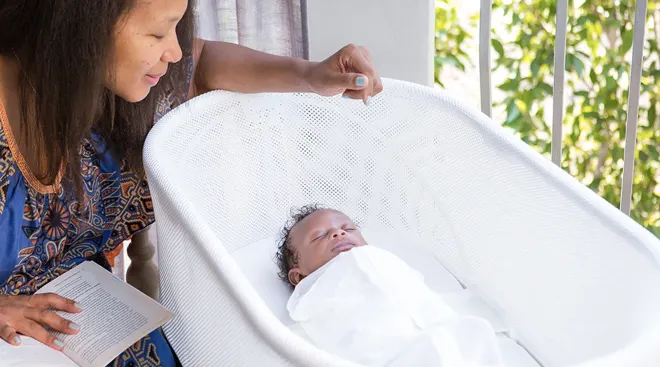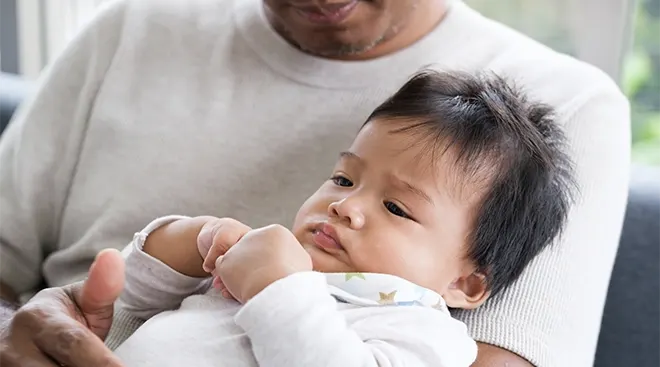The Cry It Out Method: Is Extinction Sleep Training Right for You?
After months of severely fragmented (or virtually nonexistent) shuteye, the prospect of getting your baby to sleep through the night can be downright thrilling. But the journey can also feel a little unnerving—especially if you’re thinking about letting baby cry it out.
The cry it out method—also called extinction sleep training—is hailed as a no-nonsense way for getting babies to fall asleep on their own quickly and easily (and put themselves back to sleep if they wake up during the night!). The only problem? As the name implies, it typically involves some tears, leaving many parents wracked with anxiety and guilt. Here’s what the experts have to say about the pros and cons of this method, plus how to tell whether cry it out sleep training is right for your family.
The cry it out (CIO) method is a type of sleep training that involves putting your baby to bed while they’re still awake and letting them cry until they fall asleep without any help from you. The same principle applies if baby wakes up in the middle of the night; the goal is for them to be able to self-soothe. CIO is sometimes called extinction sleep training, since you’re working to eliminate crying at bedtime and in the middle of the night in one fell swoop, rather than slowly reducing the amount of bedtime crying over time. Basically, the idea is that if you leave your little one in their room and don’t respond to their cries, they’ll eventually stop.
It might sound harsh. But while the cry it out method is definitely controversial, it has stuck around because it can be effective. “It can be a good option for babies who are overstimulated by their parents’ presence as they’re learning how to fall asleep independently,” says Kaley Medina, a certified pediatric sleep consultant and owner of Live Love Sleep. “It can also be a good option for parents who don’t wish to stay in the room with their child because they feel overwhelmed by their child’s cries.”
On the other hand, plenty of parents—as well as some pediatricians and sleep experts—aren’t totally on board with letting a baby or toddler cry indefinitely. And even among those who say it works, you’d be hard-pressed to find a parent who finds the process easy or enjoyable. Listening to baby cry is stressful, and the cry it out method method can have you doubting yourself as a parent.
Cry it out almost always involves letting your baby cry at bedtime. When people talk about this method though, they might be referring to a variety of similar techniques. Traditional cry it out sleep training encourages parents to avoid any and all interaction or check-ins; other methods are a little more lenient. Here are the most common iterations of CIO:
- Cry it out. This is a form of extinction sleep training which involves simply letting your child cry at bedtime or during night wakings without any help or check-ins from you. (It’s sometimes called the Weissbluth method, since it was popularized and endorsed by pediatrician Marc Weissbluth in his book Healthy Sleep Habits, Healthy Child.)
- Ferber method. This is a type of graduated extinction sleep training. You let your child cry for set periods but come back to offer comfort at certain intervals. Developed by pediatrician and sleep expert Richard Ferber, this method involves coming back into your child’s room at timed check-ins that gradually grow longer each night. Offering verbal comfort is fine, but you’re not supposed to pick baby up. Ferber originally outlined the details in his book, Solve Your Child’s Sleep Problems.
- Bucknam and Ezzo method. Popularized in the book On Becoming Baby Wise, this method instructs parents to let babies cry it out for 15 to 20 minutes. Pediatrician Robert Bucknam, MD, and Gary Ezzo assert that by 12 weeks, baby should be sleeping 11 consecutive hours at night. During the day, parents and baby should follow a strict eat-wake-sleep routine.
- Hogg and Blau method. This version of the cry it out method claims that babies are capable of sleeping through the night once they reach 10 pounds. Parents can check in on babies while they cry it out, but the visits should be very brief. (Pick baby up, reassure them and put them right back down!)
- Giordano and Abidin method. This technique recommends letting babies cry for three to five minutes starting at 8 weeks. By 12 weeks, they say a baby should be logging 12 straight hours of shuteye per night. With this technique, nighttime feeds should be replaced by more frequent daytime feed (every three hours.)
The cry it out method is about as straightforward as it gets. Here’s how you do it, according to the Cleveland Clinic:
- After wrapping up baby’s usual bedtime routine (which may involve bath, books, feeding, etc.), put them into their crib. They should be drowsy but still fully awake.
- Say goodnight however you typically do, then leave the room.
- Don’t go back into baby’s room, even if they cry, until it’s time to wake up in the morning (or until their next scheduled night feed, if you’re still doing one.)
One important note: Make sure you’re putting baby in a safe sleep space: an empty crib with no loose bedding, pillows or stuffed animals. You might also consider using a video baby monitor for some extra peace of mind. Of course, if you’re ever concerned about baby’s safety, don’t hesitate to do a quick pop in to check on them; just minimize interaction.
The first night, as you might imagine, can involve a lot of crying or protests from baby. But the whole process shouldn’t last long. If you’re not going back into their room to calm or feed them, your little one will quickly figure out how to soothe themselves. “Within three to four nights, parents usually see big improvements with the amount of time it takes their baby to fall asleep,” Medina says.
Using the cry it out method for night wakings
Baby goes down at bedtime fine but has a habit of crying or fussing in the middle of the night? Your operating instructions are pretty similar: No matter what time the crying starts up, don’t go into her room.
The exception to this rule is if you’re still doing an overnight feeding. In that case, you’d decide ahead of time when the feeding should happen and respond to crying in that specific window of time, Medina explains. “Keep the baby awake and alert during the feeding, and after the baby is finished, put them back into the crib awake,” she says. Again, if there are safety concerns (or if you suspect a dirty diaper) and need to pop in, keep it swift and get out fast, or you could be setting yourself up for failure.
Using the cry it out method for naps
The same rules for letting baby cry it out apply at nap time, even if it means that your little one misses a good chunk of rest for a couple of days. “Parents need to be consistent with how they’re putting their child down to sleep at both bedtime and naptime so that their child can develop a consistent sleep strategy of their own,” Medina says. In other words? When you double down with cry it out at night and naptime, baby is a lot more likely to get the hang of the new routine.
So what’s the recommended cry it out method age? “Parents should implement sleep training when developmentally appropriate for a child to sleep through the night,” says Fadiyla Dopwell, MD, a developmental-behavioral pediatrician at Pediatrix Developmental Medicine of Dallas. That typically happens between the four- and six-month mark, according to the Cleveland Clinic. That goes for whether you’re doing traditional cry it out, a graduated extinction method or another form of sleep training. By this age babies have developed the capacity to self-soothe and have a more regulated sleep-wake cycle. If you want to start sleep training but aren’t sure whether baby is ready, talk to your pediatrician.
No forms of sleep training are appropriate for newborns, Dopwell says. Very young infants need to eat every two to three hours, including in the middle of the night. Just as important, responding to their cries sends the crucial message that their needs are being met, notes the American Academy of Pediatrics. Moreover, this helps them form healthy attachments and lays the foundation for learning how to regulate their emotions.
True cry it out doesn’t come with a time limit for crying, whether the protests go on for five minutes or an hour. In fact, going in to comfort your baby after letting them cry for an extended period will probably make the process harder. “If you let them cry for an hour and then go in, you’ve set the bar for how the second night will be,” says Macall Gordon, MA, a certified pediatric sleep consultant and senior lecturer of applied psychology at Antioch University.
That’s not to say that you have to let your baby cry for that long. “If a parent asks me, I say it’s what they can tolerate,” says Dopwell. “I don’t think most parents can tolerate constant crying for 20 minutes, but it varies by individual.” If you want to comfort your baby or pop in for a quick check after just a few minutes, that’s totally fine; try a graduated extinction method or a more gentler form of sleep training instead.
Wondering if your older baby or toddler can handle crying for longer? Ultimately, there’s no right or wrong answer for how much crying is okay, Gordon says. But cry it out tends to be less effective for toddlers in general, especially once they’ve moved into their own bed (or can climb out of their crib). “What will most likely happen is the child will follow the parent out of the room. At that age, parents likely need to use a combination of rules and consequences to teach their child how to stay in bed all night,” Medina says.
Keep in mind that the cry it out method isn’t right for every baby (and every parent), and if you’ll be able to tell within a few days whether it’s a good fit. If your little one is still crying hard after three nights, that’s a sign to pause and consider trying another sleep training method, Gordon says.
Critics of the cry it out method say that leaving a baby to cry for extended periods is cruel. “In my mind, there are limits to how long one should allow a child to cry,” says Robert Hamilton, MD, a pediatrician at Providence Saint John’s Health Center in Santa Monica, California. He recommends a Ferber-style sleep training method that starts with checking on a baby after three to five minutes of crying. “Others would argue that intermittent checking prolongs the process. I’m willing to accept that criticism. But, overall, I think it’s more humane,” he says.
What’s more, extended crying can potentially stress babies (and parents) out. One study, for instance, did find that lack of maternal response to crying can increase a baby’s levels of the stress hormone cortisol. But a heightened level of stress during a crying bout, while undesirable, doesn’t automatically translate to long-term problems. The research is mixed. While some research asserts that prolonged crying could affect baby’s brain development and cognitive function, making it harder for them to learn how to regulate their emotions, other studies have found that letting babies cry it out at 6 months won’t affect their socioemotional development at all or harm their attachment to their mothers, later in life.
So is letting your baby cry it out harmful or not? “I would say it’s not always harmful and it’s not never harmful,” Gordon says. "We have to consider the age, development and temperament of the child.” A couple of nights of crying for 15 to 30 minutes won’t be fun for anyone, but it’s unlikely to have long-term effects.
Deciding to use cry it out for sleep training is a personal choice made based on what you think is best for baby and your family. If you’re thinking about giving it a try, these tips can help set you and your little one up for success:
- Clear your calendar. Learning to fall asleep solo is a big transition for most babies, so don’t do it when other big events or transitions (like starting at a new daycare, going on vacation or illness) are happening. If possible, try to block out a few nights where you don’t necessarily have to be on top of your game the next day, Dopwell recommends. Even though you’re not going into your baby’s room for check-ins, listening to their cries will probably make it impossible for you to sleep.
- Ready the bedtime routine. Routines help baby wind down and send the cue that lights out is near, so they can help make bedtime smoother in general. The bed, PJs, books and snuggles sequence is always a winner.
- Keep it consistent. Whether you’re doing full cry it out or a graduated extinction method, stick with the plan, Dopwell advises. Making changes every night (or multiple times a night) will only confuse baby and prolong the sleep training process.
- Be gentle (on yourself). The combo of no sleep and high stress means you might be on edge during the sleep training process, Dopwell says. That’s normal. Don’t beat yourself up over it, and try to find ways to relax when you can. If you need a break from listening to the crying, for instance, head out for a walk while your partner holds down the fort.
- Be patient. The first night of sleep training is always the hardest, Medina says. But you should notice an improvement each night afterwards. And if that’s not the case? It may be time to move on to a new method.
- Consider trying something else. The cry it out method works like a charm for some babies; for others, not so much. If your gut tells you that baby needs a gentler sleep training method, don’t be afraid to explore the options. “Sleep training methods are all about changing your baby’s patterns. It’s just a matter of how fast or slow you decide to go,” Gordon says.
About the experts:
Fadiyla Dopwell, MD, a developmental-behavioral pediatrician at Pediatrix Developmental Medicine of Dallas in Texas. Shereceived her medical degree from St. George’s University School of Medicine in True Blue, Grenada.
Macall Gordon, MA, a certified pediatric sleep consultant and senior lecturer of applied psychology at Antioch University in, where she also received her master’s degree.
Robert Hamilton, MD, a pediatrician at Providence Saint John’s Health Center in Santa Monica, California. He received his medical degree from UCLA Geffen School of Medicine in Los Angeles, California.
Kaley Medina, is a certified pediatric sleep consultant and owner of Live Love Sleep.
Please note: The Bump and the materials and information it contains are not intended to, and do not constitute, medical or other health advice or diagnosis and should not be used as such. You should always consult with a qualified physician or health professional about your specific circumstances.
Plus, more from The Bump:
Navigate forward to interact with the calendar and select a date. Press the question mark key to get the keyboard shortcuts for changing dates.








































![Tan France, celebrity personality from the popular TV shoe]w Queer Eye.](https://images.ctfassets.net/6m9bd13t776q/2uqRZn7bkb4nWv28drOW16/98b7493289f8f84d699ffa7516be8f90/tan-france-baby-sleep-products-660x367.jpg?fm=webp&q=75&w=660)











